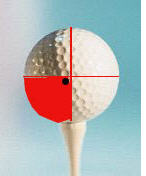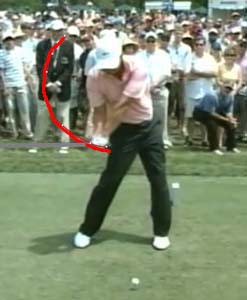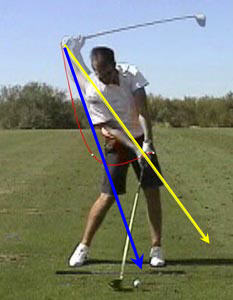
2-J-3 (Visual Equivalents)
In short, Visual Equivalents are the 'illusions' of the club and the dimensions of the motion of the club the golfer sees when they are looking down at the ground and the ball. Just like the old saying in golf 'what you feel isn't real', the same could be said for what the golfer sees. As Homer stated in the book in List #1 (and something I've already 'translated':
When the "Facts" are understood the "Illusions" not only cease to mis-lead but can be utilized. - Homer KelleyJohn Furze has a fantastic article on 'Visual Equivalents' on one his Web Sites. In particular, Furze shows a picture of part of Ben Doyle's 'Facts and Illusions' Mat:

Homer states that the FACT is the geometric plane line is the Basic Delivery Line. That is the blue line on the mat in the picture above. If you can't see it, then go to the Furze article and check it out there. However, that's not the optical illusion the golfer sees. Instead the golfer 'sees' the clubhead coming into the ball on a curved path. We talked about 'Arc of Approach', which golfers, particularly swingers can utilize. However, this is a VISUAL arc of approach. So if you are legitimately using an ANGLE of approach, you will still have a VISUAL ARC of approach. In other words, if your clubhead is coming into the ball at an angle, you will still see the optical illusion of it coming into the ball with a blurred arc.
The big part of 2-J-3 is that it wants you to focus your eyes on the 'inside aft' part of the ball. Some do not know what that means, but when I hear the word 'aft', I came up with my own acronym for that:
Away
From
Target
For instance, if you're a right handed golfer and are looking for the Aft part of the clubshaft, that is the side of the shaft towards your right foot (the side that is furthest Away From Target). So understanding what the word 'aft' means is important for understanding other component variations mentioned in TGM. Here's a pic of the inside aft part of the golf ball, looking from the DTL view.

This is also part of the 'swinging out to right field.' Now, I've talked about 'swinging left' with D-Plane, but I feel that 'swinging out to right field' does have its importance as the higher handicapper is too far above the play (aka Over the Top), thus swinging out to right field helps the golfer eliminate the OTT move. And if you eliminate your flip and want to apply the D-Plane rules and 'swing left', you can still achieve that while hitting the inside-aft part of the golf ball. Simply imagine you're swinging on a plane board and just imagine that you are rotating the plane board SLIGHTLY to the left.
2-K (Endless Belt vs. The Flail)
I debated about getting into 2-K since it's a bit difficult to understand and I had yet to meet a fellow TGM'er that told me that 2-K really helped them with their swing. But then I read an interview with GSED Alex Sloan, one of Homer Kelley's first 3 students. Here's an excerpt of the interview with Mr. Sloan:
Homer talked at length to us about “The Endless Belt Effect” (2-K) and it was not until I got home from Seattle that I fully appreciated what he had told us. I was on the range hitting balls one day and I started thinking about this. The message I share with all my students is this. Once we start the swing, we must do nothing to try to increase the belt speed before impact. This is established at start down.With that, I will used John Furze's (GSED) article explaining The Endless Belt Effect since he does a much better job of translating it than I do. Here's a link to Furze's article
I was very guilty of trying to increase belt speed just before impact. As Homer explained it, we will get an increase in clubhead speed for a brief time but during the impact interval, the clubhead will actually be slowing down. We want to have the same belt speed from Start-Up (8-4) to the Finish (8-12). Once I was able to do this, it made such a tremendous difference. The lesson is this; do NOT try to add clubhead speed during the release interval. Keep hand speed constant. Once I realized all this, I started calling it the “Million Dollar” golf lesson. Hitting or swinging it is the same. - Alex Sloan, GSED

The clubhead and belt (hands) travel at exactly the same speed; however there are two (2) different surface speeds between the pulley and the clubhead.So keep in mind, in the diagram above, the hands are essentially the 'belt' on the pully system that is described above.
The Belt (Hands) speed never changes but the Clubhead speed increases as it goes around the pulley. The hands act as the belt, they must not speed up, slow down, or become jerky.So, the belt on the pully system does not change speeds. Meaning that the hand speed in the downswing does not change. So if your hands are moving at say 50 mph (just a random number) at the startdown then they should be moving at 50 mph thru the impact interval. But, the clubhead speed DOES change as it goes around the pull, particularly as it goes around the wheels of the pully system.
The hands do not change speed during the release. The smaller the pulley the slower you can swing.
The later the delay the slower the hand speed. The faster you swing the harder it is to keep the club from flying out.
Where it says 'the smaller the pully, the slower you can swing' and 'the later the delay the slower the hand speed' sort of mean the same thing.
This actually has to do with 'trigger delay' and hand delivery paths. Looking from the Face On view, the path the hands take to the ball determine the 'delivery path.'
Here's a pic of Anthony Kim's 'circular delivery path.'

Here's a pic of Aaron Baddeley's 'straight line delivery path'

The red line shows Baddeley's actual path of his hands. It's not a perfect straight line, but that's what is considered a 'straight line delivery path' whereas Kim's hands move in an obvious circular motion.
The straight line delivery path that Baddeley makes the 'pulley' smaller. The circular path that Kim has makes the 'pulley' bigger. So Baddeley doesn't require great hand speed to hit the ball well. On the flip side, Kim requires more hand speed because his pulley is bigger.
Trigger delay is basically how long the golfer takes to 'release' the club in the golf swing. Somebody like Ben Hogan had 'maximum' trigger delay. This pic of Hogan and Lynn Blake show a lot of trigger delay.

However, somebody like Lindsey Gahm shows a lot less trigger delay. Hogan (and Blake) are employing what's called a 'snap release' (maximizing that lag and delaying the release for as long as possible). Ms. Gahm is utilizing what's called a 'full sweep release' where the club steadily releases from the startdown.
So with a snap release, which is done using a straight line hand delivery path, that means a small pulley. Small pulley = the golfer CAN use slower hand speed.
With a full sweep release, whichis doen with a circular hand delivery path, that means a big pully. Big pulley = the golf needs faster hand speed.
Snap release and full sweep release along with hand speed is much like a boat towing a skier. Let's say the skier wants to go around in a circle. If the boat takes a large circle to tow the skier in a circle, the boat has to travel at a higher rate of speed to keep the skier traveling at a reasonably efficient level. However, if the boat is traveling on a 'tighter' circle, the boat doesn't need to move as fast to keep the skier traveling at an efficient level.
In the Furze article on Endless Belt, he talks about Endless Belt and it's effect on power.
Furze would like the golfer to incorporate more of a snap release to help create power and here's why. While a snap release can allow the golfer to operate effeciently with slower hand speed, if the golfer can operate a snap release with good hand speed, they will hit the ball further.
Now, Anthony Kim who uses a circular path and something called a random sweep release which is a release between full sweep and snap release is one of the longest hitters on tour. That's because he has fantastic hand speed. Sergio Garcia employs a snap release and hits the ball about the same length as Kim. Sergio has good hand speed, but Kim's hand speed is probably fast enough to make up the difference in trigger delay.
Tom Watson was pretty long for his day and he uses a Full Sweep Release, much like the video of Lindsey Gahm. But again, he had very good hand speed to make up for the lack of trigger delay.
The two problems golfers tend to have when it comes to the Endless Belt effect is either the hands start to move faster or they slow down (more likely) instead of staying at the same rate of speed. I had a problem with my belt (hands) slowing down and once I focused on maximizing lag pressure at impact, that kept my belt (hands) moving at a constant rate of speed.
3JACK
12 comments:
Once again...very good post! I'm glad you didn't leave this out. This constant hand speed thing is something else I never knew or heard.
Yeah, I don't like the way it's explained in 2-K of TGM, but it's very helpful to understand the concept and then use the concept when we get into the snap release, full sweep, random sweep etc.
For me personally this has been the most useful post so far Richie. It has really cleared up a few things for me. Great stuff as usual.
Richie: The part about the endless belt is very confusing. How is possible to have any "straight" movement in your downswing when all the parts are rotating? Does the left arm or right arm suddenly or temporarily get shorter? Look at the pictures of Hogan and Lynn you posted showing their DS. Their left arms are fully extended. I don't see how Scott's right arm could possibly fold enough to get to the position shown? Experiment: If I put my left arm across my chest, simulating the top of the BS, I don't see anyway I can make my left hand move in a straight line, unless I just lunge forward. If my shoulders move rotationally, then the left arm will move in a circle too.
DanL.
Dan, I think the rotation can help a golfer use a straight line delivery path. It's not all that hard to do or see, especially if you understand the 'aiming point concept', which I will get into later. The problem a lot of golfers have is that they don't hit down enough on the ball with an iron and that causes them to use a circular delivery path. Again, nothing wrong with a circular delivery path, but in the case of the average amateur they need to get more or a straight line delivery path because when they use a circular path, they are just doing so because they are losing lag and flipping through.
Rich, Thanks for the reply. I'll look forward to more detail about the aiming point method and the straight line delivery path! DanL.
Since February of this year when I first came to your blog I immediately decided to adopt what TGM describes as a “hitter” type pattern. I didn´t have any real idea how I would fare at the beginning but I was so immensely frustrated with “swinging” that I just abandoned my old swing completely and began building a new swing based entirely on the TGM adhering to the principles that specifically describe the dynamics of the hitter. Now I have an obsession with the game which I´m not sure is healthy, but I have put in hours and hours of working with this new pattern and have done so almost every day now for the last 8 months. The thing that got me hooked is that the very day I read about hitting and the Magic Of The Right Arm I went to the park that is next to my house and by sheer luck hit a powerful compressed 8 iron shot that carried 12 yards further than my old swing, 154 yards instead of 142. I know this because I have lasered every corner of the park and know distances quite accurately in my swing, im obsessed with distances. Then almost immediately I lost it but I knew I was on to something and the last months have been a journey of constant discovery. Basically through technical and mechanical concepts introduced in your blog, trial, error and a lot of practice I am now currently at an 15.1 hdc down from 19.8, and that´s this summer after having completely revamped my swing! This is entirely thanks to my improved ballstriking because my putting has been atrocious this summer as I have only worked with my new swing and completely neglected my putting, I can´t wait for the next golf season to see what happens when I get those dreaded three putts sorted out (HOPEfully), I HATE three putting when I have GIR. Also I would like to say that this concept your are talking about here that I only came to understand recently about constant speed of the band on the pulleys along with the concept of REALLY down and REALLY out finally gave me the stability I wanted. Although I knew "hitting" was better for me the new swing would be haphazard at times because unknowingly I was reverting to circular delivery and It would take out both power and accuracy and I didn´t have a clue why and then suddenly power and accuracy would return again, my AHA moment was being aware of the difference in circular and straight line delivery, crucial for me. Armed not only with this concept but the understanding of the mechanics of a constant speed straight line delivery, really down and really out has finally made the swing much more reliable, accurate and more powerful than my old swing. Sooo, thank you for your blog, reading about TGM in it has changed my game and I love having mechanical understanding associated with feel. The swing was mysterious for me once but now I understand better what Im doing and when things go wrong I know better how to fix them. Good stuff!
Jon S.
That's great to hear, Jon. Now we just got to get you putting better.
Indeed, I was wondering, do you have any recommendations on where to start. By that I mean a practice routine or something in that manner. I have never worked on my putting but I have the idea of just marking out different distances and practicing putting to them. Any suggestions would be greatly appreciated!
Jon S.
I would suggest reading this old blog post first (http://3jack.blogspot.com/2009/08/3jacks-steps-to-rejuvenating-your.html). Get the putting stroke components to 'match', understand how to read greens, develope some touch and get a putter that fits your stroke, fits your eye and reduces skid.
When I'm struggling with putting I work heavily on speed. Not only will better speed increase the putts you make, but if your aim is off, then you can at least limit yourself to 2-putts instead of 3-putts because you're getting the putt near the hole.
Even still, I suggest to keep working on swing and the ballstriking. As AimPoint golf's stats show, GIR is the #1 stat that correlates to scoring avg. Putts/GIR is #2, but that still has a lot to do with ballstriking because if I'm hitting my shots to 10 feet vs. somebody who is hitting them to 30 feet, I've got a much better chance making mine even if I'm a much worse putter.
I give birth to interpret a few of the articles on your website now, and I extremely like your line of blogging. I added it to my favorites web stage file and resolve be checking promote soon. Please check in view my put as highly and leave to me conscious what you think. Thanks.
thanks pro this tips
pmu
turf
Post a Comment